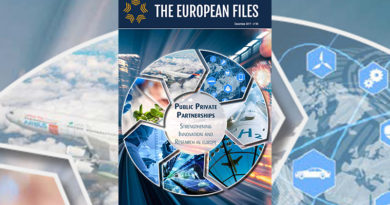
European Green Deal & CSRD: what if the Extended Producer Responsibility (EPR) model was a path to follow for environmental performance?
Presented in 2019 by the European executive, the Green Deal was conceived as the cornerstone of the European Union’s “New Growth Strategy” for the 2019-2024 mandate. It encompasses a set of policies aimed at achieving three major objectives:
- no net emissions of greenhouse gases by 2050,
- economic growth decoupled from resource use,
- no person and no place left behind.
Achieving these objectives requires a substantial transformation of the European economy, primarily reliant on the mobilization of all economic actors.
The European Union aims to guide investments and consumption towards companies and projects that are virtuous and dedicated to the well-being of the planet and society.
The recently adopted taxonomy regulation aims to respond to this demand and classifies different activities to define those considered sustainable and non-sustainable. In the field of circular economy, the criteria selected include the possibility of reusing packaging and the integration of mechanically recycled materials[1].
To complement the European legislative framework, the Corporate Sustainability Reporting Directive (CSRD) applies downstream by requiring companies to standardize and normalize their sustainability reports. To facilitate decision-making and guide consumers and investors towards sustainable projects, it is essential that they have access to transparent, comprehensive, and standardized information. That is the objective the CSRD is aiming for.
Companies are henceforth accountable for their actions, considering this legislation requires to provide precise reporting on their environmental and societal impacts (with reference to a set of indicators defined in the European Sustainability Reporting Standards (ESRS)). Companies shall also adopt transition strategies, setting quantifiable objectives, and developing associated action plans.
On the environmental aspect, the CSRD considers the circular economy as a driver of performance.
Circular economy: a model promoted by the CSRD
The ESRS E5 standard[2] requires companies to assess and report various indicators related to the founding principles of the circular economy and waste hierarchy. These indicators refer to, but not limited to, the company’s ability to transition from the extraction of virgin materials to the use of secondary raw materials, the weight of materials used, recycled and non-recycled waste. These data help to understand how the company’s policy incorporates resources depletion into its strategy and, therefore, initiatives or commitments made by the company in response to ensure a transition towards a fully circular economy.
Given the interdependence of economies, access to raw materials, and market constraints, the establishment of an effective circular economy model requires collaborative efforts among stakeholders to achieve a large-scale impact. The Extended Producer Responsibility (EPR) scheme provides a solution to tackle this challenge.
EPR, CSRD, and circular economy: a real asset for increased environmental responsibility and performance
EPR gives to all companies selling products the responsibility of the environmental impact of the products they sell (carbon, resource, and biodiversity impact). To exercise this responsibility, producers gather into PROs, to which they declare each year the number of products sold, and to which they pay fees. With those financial contributions, PROs operate eco-design, reuse, collection, sorting and recycling programmes, as well as awareness and educational campaigns to fight against littering of waste.
The CSRD strengthens the development of the circular economy already initiated by EPR schemes.
In the early 1990s, France implemented the EPR scheme for households packaging, focusing on recycling as a mean to address environmental impacts. Today, EPR faces new challenges:
- Reducing, Citeo recommends minimizing single-use packaging as much as possible to limit raw material extraction, preserve resources, and reduce transportation-related impacts. Citeo has developed a “LESS” methodology to assist its clients enabling them to identify all possible options for reducing their packaging. Additionally, Citeo initiates calls for projects to support, financially, the development of reduced packaging solutions (elimination of plastic grouping packaging, lightweighting glass packaging, etc.).
- Supporting the implementation of a reuse model at a larger scale, notably through the establishment of a new “ReUse” approach. This initiative aims to pave the way for a shared and national reuse system for food packaging in large and medium-sized stores, aligned with the French 10% of reused packaging by 2027 target.
- Ensuring the recyclability of 100% of plastic packaging, improving recyclability, and increasing the incorporation of recycled material. To achieve these objectives, Citeo applies an eco-modulation system that serves as a financial incentive. Packaging that is more difficult to recycle incurs an EPR fees penalty, whereas those incorporating recycled materials receive a bonus[3].
EPR schemes can also enable companies, with the help of PROs, to meet the requirements of the ESRS E5 standard through the following measures:
- Sharing resources: EPR fees and the optimisation of schemes enabling businesses, of all sizes, to contribute to a circular economy by developing research and development projects in eco-design, supporting the emergence of a reuse market, or creating new recycling streams.
- Access to comprehensive data for an overview and the initiation of concerted actions. PROs share non-financial information essential for companies, serving the dual purpose of ensuring compliance with the CSRD and facilitating the pursuit of changes leading to enhanced environmental performance. This includes details like the recyclability rate of packaging introduced to the French market.
- Accessing expertise and receiving support in adapting products and production methods to align with the circular system in place and market expectations (eco-design in accordance with collection, sorting, reuse, and recycling processes).
By contributing, companies play a role in achieving these objectives, aligned with their individual objectives.
“The paradigm shift implied by the CSRD and more broadly the Green Deal also compels EPR schemes to set themselves ambitious targets.”
Environmental performance as the “raison d’être” of Citeo
While the CSRD will only become mandatory for Citeo from 2025 onwards, the company is already making commitments and implementing structural changes.
The definition of our purpose for the planet is translated into our raison d’être: engaging and supporting economic actors in producing, distributing, and consuming while preserving the planet, its resources, biodiversity, and climate. By enshrining this raison d’être in its bylaws, Citeo has become one of the first Mission-oriented Companies in France.
This status urges us to adopt a broader and long-term vision of our impact, both as a PRO serving a circular economy framework and as a company. Thus:
- Our actions and decisions are conceived in light of our raison d’être. We are guided by a Mission Committee, composed of external stakeholders, responsible for advising us and ensuring the proper trajectory of our social and environmental objectives.
- Our definition of performance is based on two inseparable criteria: financial/economic performance and environmental performance. For instance, the former Finance department of the company has transformed into the Environmental and Economic Performance Management department, elevating the monitoring of environmental performance indicators to the same level as financial performance indicators. This choice reinforces the role of Finance, tasked not only with ensuring the financial sustainability of the company but also with promoting its overall sustainability, in collaboration with all departments.
- Convinced of the virtues of the EPR model, we commit to its development on a European and international scale. Therefore, Citeo is an accredited observer at the UN Environmental Programme as part of the negotiations for an international binding instrument on plastic pollution.
- Our actions extend beyond packaging alone, as any waste poses a threat to biodiversity. The integration of a biodiversity strategy aims to address the prevention and reduction of litter at the regional and national levels.
We are confident that the CSRD will accelerate the momentum in favour of the environment and a virtuous economy, where the circular model and EPR have a crucial role to play.
[1] Delegated Regulation (EU) 2023/2485 amending Delegated Regulation (EU) 2021/2139, June, 27 2023.
[2] The ESRS E5 standard corresponds to the norm that defines the format and content of sustainability reporting for large companies concerning resource use and the circular economy.
[3] Each company contributing to a PRO pays an eco-contribution, the amount of which depends on the weight, material, and type of packaging. In addition to this, there are eco-modulations, which are bonuses (discounts on the eco-contribution) or penalties (premium on the eco-contribution) based on whether the packaging is recyclable, incorporates recycled material, promotes on-pack awareness of sorting, etc.




